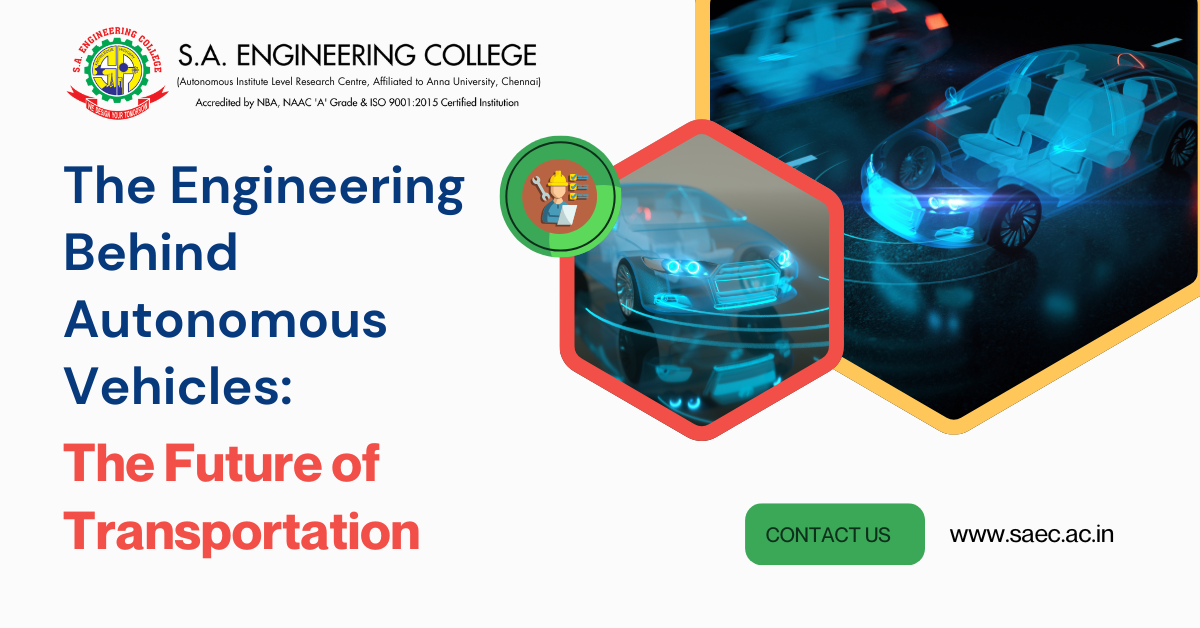
The Engineering Behind Autonomous Vehicles: The Future of Transportation
- Posted by S.A.E.C
- Categories Engineering Solutions
- Date April 15, 2025
Autonomous vehicles (AVs) represent a profound leap in transportation technology. What was once considered a futuristic dream is quickly becoming a tangible reality, transforming the way we travel, commute, and perceive mobility. Autonomous vehicles use an intricate combination of sensors, machine learning algorithms, and sophisticated engineering to drive without human input. These innovations are reshaping not just personal transportation but also commercial logistics, public transport, and even urban planning.
In this article, we will delve into the engineering principles that power autonomous vehicles, exploring the key technologies, design considerations, and challenges faced by engineers.
The Key Engineering Components of Autonomous Vehicles
Autonomous vehicles rely on a diverse set of technologies to ensure they can operate safely and efficiently. The key engineering components behind AVs include:
1. Sensors and Perception Systems (LIDAR, Radar, Cameras)
- LIDAR (Light Detection and Ranging): LIDAR sensors emit laser pulses to measure the distance between the vehicle and objects around it. These sensors provide highly accurate, 360-degree views of the environment, generating detailed 3D maps of the vehicle’s surroundings. The use of LIDAR is critical for detecting obstacles, pedestrians, and other vehicles, especially in low-light conditions.
- Radar: Radar sensors are used to detect the speed, distance, and position of objects surrounding the vehicle. These sensors excel at detecting moving objects and work well in adverse weather conditions, such as fog, rain, or snow.
- Cameras: Cameras are essential for object recognition and identifying road signs, traffic lights, lane markings, and pedestrians. High-definition cameras with advanced image processing capabilities are used to detect and classify objects in the vehicle’s path. They also provide crucial information for vision-based systems like lane-keeping assistance and automatic parking.
Each of these sensors plays a vital role in providing real-time data that is fused together to create a comprehensive view of the vehicle’s surroundings. The integration of these sensors is known as sensor fusion and is essential for making safe and informed decisions.
2. Control Systems and Actuators
Once the sensors have collected data, control systems process the information and send commands to the vehicle’s actuators, which control the car’s movement. The engineering of control systems in autonomous vehicles involves the following components:
- Steering and Throttle Control: Autonomous vehicles must have highly responsive steering and acceleration control systems that can operate without human input. These systems are typically electric and are controlled by a central computer system, which processes sensor data and sends signals to actuators that control steering and throttle.
- Braking System: Autonomous vehicles are equipped with sophisticated braking systems that allow the vehicle to safely decelerate, stop, or apply emergency brakes if necessary. These systems are tightly integrated with the vehicle’s overall control architecture, allowing for smooth and precise control.
- Vehicle Dynamics and Stability Control: Ensuring that autonomous vehicles maintain stability while navigating curves, uneven terrain, and varying road conditions requires precise control of the vehicle’s dynamics. Engineers design sophisticated stability and traction control systems that work seamlessly with the vehicle’s sensors and control systems to ensure safety at all times.
3. Computing and Artificial Intelligence (AI)
At the heart of an autonomous vehicle lies its central processing unit (CPU), a highly advanced computing system that processes data from the vehicle’s sensors, interprets the environment, and makes driving decisions. This requires sophisticated AI algorithms capable of machine learning, decision-making, and path planning.
- Machine Learning and Deep Learning: Autonomous vehicles use machine learning algorithms, particularly deep learning, to improve their decision-making capabilities over time. These algorithms are trained on vast datasets that include millions of hours of driving experience, allowing the system to recognize patterns, classify objects, and predict the behavior of pedestrians and other vehicles.
- Path Planning and Navigation: Path planning algorithms help the vehicle decide the best route and trajectory, taking into account road conditions, traffic, obstacles, and other dynamic factors. These algorithms use real-time data to make complex decisions such as lane merging, avoiding collisions, and navigating through intersections. Engineers use advanced methods like A search algorithms* and Dijkstra’s Algorithm for optimal pathfinding and routing.
4. Communication Systems (V2X)
Autonomous vehicles must communicate not only with other vehicles but also with infrastructure such as traffic signals, road sensors, and smart city networks. Vehicle-to-Everything (V2X) communication is an integral part of AV engineering, enabling real-time exchange of information between vehicles and surrounding systems.
- Vehicle-to-Vehicle (V2V): This system allows AVs to communicate directly with each other to share information such as speed, position, and trajectory, enhancing safety and preventing accidents.
- Vehicle-to-Infrastructure (V2I): AVs equipped with V2I systems can interact with traffic signals, road signs, and sensors embedded in the road. This can optimize traffic flow, help with traffic signal timing, and reduce the chances of collisions.
These communication systems help autonomous vehicles become more aware of their surroundings and respond to external conditions, improving safety and efficiency.
The Future of Autonomous Vehicles
The future of autonomous vehicles is promising, with significant potential to transform the transportation landscape. As engineering challenges are addressed, we can expect to see more reliable, safer, and cost-effective AVs on the road. The potential benefits of widespread AV adoption include:
- Improved Safety: By eliminating human error, autonomous vehicles could drastically reduce the number of traffic accidents and fatalities.
- Efficiency and Sustainability: AVs could optimize driving routes and reduce congestion, leading to lower fuel consumption and less pollution.
- Enhanced Mobility: Autonomous vehicles could provide greater mobility for people who are unable to drive, such as the elderly or disabled.
As more companies, from automakers to tech startups, invest in AV technology, the dream of fully autonomous cars becomes increasingly feasible. The engineering advancements that are happening now will lay the foundation for the vehicles of tomorrow, transforming transportation in ways we can only begin to imagine.
Conclusion
Autonomous vehicles represent a major milestone in the evolution of transportation. Through the integration of advanced sensors, AI, machine learning, and robotics, engineers have created systems that can navigate and make decisions independently of human input. However, the path to fully autonomous vehicles is not without its challenges, from ensuring safety and reliability to addressing ethical dilemmas and cost concerns.
The future of autonomous vehicles is not just about self-driving cars; it’s about transforming the way we live, work, and interact with the world around us. With further innovation and collaboration, autonomous vehicles may soon change the transportation landscape, paving the way for smarter cities and a more connected world.

